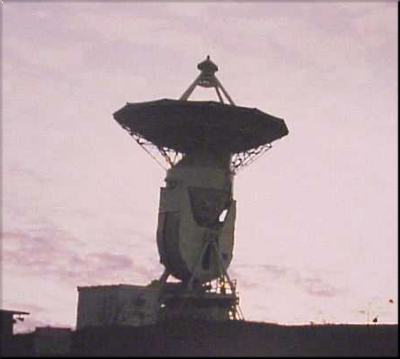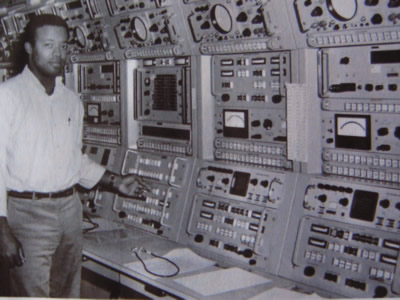USB (Unified S Band)
 Clarence Sommner Assigned as an electronic technician in the Unified S- Band system, Clarence operated equipment which transmitted and received voice, telemetry data and television signals from the lunar surface through the 30 ft. diameter Unified S-Band antenna. Clarence received his education at the Francis Patton School and Howard Academy. Advanced electronics training was received from the many NASA sponsored courses he attended. (source Bda Sun,01/30/71)
Clarence Sommner Assigned as an electronic technician in the Unified S- Band system, Clarence operated equipment which transmitted and received voice, telemetry data and television signals from the lunar surface through the 30 ft. diameter Unified S-Band antenna. Clarence received his education at the Francis Patton School and Howard Academy. Advanced electronics training was received from the many NASA sponsored courses he attended. (source Bda Sun,01/30/71)
Some forty years later Clarence reflects on those early days:
" I remember even before I worked at Nasa I had done a lot of courses. My initial start was with RCA correspondence. The reason, I guess, all goes back to 1960. I got a job working on the Base fueling airplanes. I went from nine pounds a week, mixing concrete along the road for Government, to twenty seven pounds per week fueling airplanes. It was a six day a week operation. It was shift work around the clock, 12 on 24 off. Three months after I was there, I was making thirty six pounds a week...that was straight pay not including overtime."
Meanwhile, Clarence had learned a lot about electronic fundamentals from RCA courses he was taking. What sparked his interest was a desire to fix his 'Playmate' car radio so that it would be possible to pick up U.S. stations during the day, especially the 24 hour news station WINS, New York. Other guys radios did it why couldn't his? He took the radio to several places who could not find anything wrong. But this frustration only served to drive Clarence to learn more about tube technology, short wave radio, walkie talkies and power amplifiers. Finally, his investigation led him to discover the problem with his radio was a broken coil in the intermediate stage of the radio. He fixed the problem and peaked the tunning so his radio worked just like the other guys. With this success, Clarence discovered that his aptitude was all in radio frequencies (RF) and he comments:
" I was like 24 hours into stuff, I was having fun like the day wasn't long enough. I think I was actually doing that before I got to work in the Power House at Nasa. But after being down there listening to those guys, and I know a couple of times I went out to a guy who used to work in 'Acq Aid' who previously was a supervisor in Ascension Islands. He was a tall guy, and was interesting just being around him."

Clarence, while working in the Power Plant, had done some correspondence courses with Nasa so he asked his boss to make an appointment for him to see about getting a job in Operations. He explained:
" At that time a lot of my colleagues in the Power House said I was wasting my time. It wasn't that I was banking to get into operations. I was certainly liking what I was doing with or without that. I was learning something, I found it very, very interesting. My supervisor Dick Dole said he would make an apointment to see the secretary about getting a job in Operations. I saw Keith Hill on Friday afternoon and was told 'I've got nothing for you right now but we'll see what we can do.' A week later he left a message down the Power House which said 'Clarence I've got nothing yet but I'm still looking.' The second week there was a message for me to come up and see him. Friday afternoon I was going in at four-o-clock to work to twelve-o-clock. I went up and saw Keith and he told me that this guy in the office here, Francis Bowen, he's going to be your supervisor and report to USB on monday morning. I think at that same time Bill Todd went to Radar, Cal Sinons went into Telemetry and Lynch went to Air to Ground, all in the same move." 
"After being assigned to USB, at first, it was like confusion! It was something to really cipher. When it came down to actual Apollo launch there was thorough testing of the whole system, both in computers and radio communication links of the tranmission testing. It was somewhat confusing. It came to a point in time however, what was actually going on became clearer, meaning we were setting up test transmitters and Telemetry was relaying information to us. The station consisted of two parts from the Telemetry section and later on was consolidated to one building. It was a matter, on the one hand, of interfacing with Goddard with one set of testing and on the other hand, interfacing with different players in a different language and what they were doing. In a sense they were actually sending information through all the communication channels ie Cable & Wireless into our system, relaying information out to the RF transmitter, verification of all information going back from a telemetry point. Telemetry was running tapes of previous missions to the transmitter and relaying all that information back to you."
"Once it was clear what was actually going on, the confusion side of what we were doing, to me, was removed and was like repeating itself. Once you saw the repeat side of things you understood it better. But that's what eight hours of testing will do for you as you lead up to a launch. In any case, it was the repeating of these activities, several times during an eight hour period that really helped me to learn the system."
" That was an interesting experience for me way back then and I enjoyed what I was doing... I never thought I would leave actually! At one point, I was running the USB. I had become very familiar with the equipment, all the operations things I knew. In fact a couple of times I wasn't there they had operator errors. Well I knew the place intimately and some of the 'stand in guys' just did what I did, not necessarily understanding why I did what I did. Things like that, I knew what would work and what wouldn't work."
The question was asked: Who was your supervisor?
"Sanderson was my supervisor. He came from Telemetry and worked in the old building. He wasn't initially my supervisor. I guess it was after the second landing on the moon that I got into USB and at that time, Ralph Roth was my supervisor. He was a smart guy, he wasn't an academic person but he had a lot of experience in the military. He was sharp, thorough, wasn't fast, but methodical and knew how to do lots of appropiate checking before the missions, using spectrum analyzers to look at the RF uplink; made sure there were no spurs on the display. I learned a lot from him. He was certainly not a racist type of character, in fact I didn't run into any racist characters in all my experience. Nobody ever pulled any pranks on me or anything like that while I was there, especially while I was a 'green horn' meaning I was a 'RF' in aptitude for the most part, an anti digital person. As it turned out, all the while I was learning things I always said to myself, 'I'm not going to be digital.' "I enjoyed RF."
(also see Vanguard Experience)

